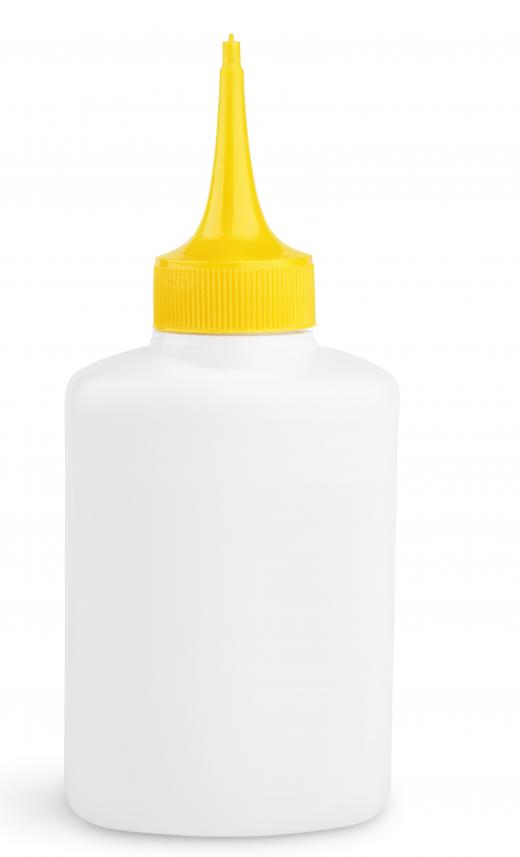Polyvinyl acetate is a thermoplastic polymer commonly used in glues, paint, and a number of industrial adhesives. Polymers are essentially large molecules linked together in such a way that they are very strong and durable. Most plastics and synthetic materials contain them. Polyvinyl acetate, which is also commonly referred to as “PVA” or “PVAc,” tends to be quite flexible and has a strong binding capability, which is one of the main reasons it’s so popular in products like glue. It is made from vinyl acetate, and has the chemical formula of (C4H6O2)n.
How It’s Made

PVA is normally manufactured through the free radical polymerization of vinyl acetate, which is also a polymer. Scientists isolate this compound first, then manipulate it in order to slightly change its structure. Most of the time this happens in water. Monomer molecules of vinyl acetate typically react when they’re submerged in water, and usually create an emulsion that is milky white in color. The emulsion fluid can in most cases be instantly processed as a polyvinyl acetate polymer by removing it from the water and allowing it to stabilize at room temperature.
Physical Properties

PVA is primarily a synthetic resin polymer. Due its non-polar nature, it tends to be insoluble in water, oils, fats, or gasoline. This makes it very durable. On the other hand, it is soluble in alcohols, ketones, and esters, so this durability isn’t without its limits. Practically speaking, this means that the polymer won’t erode or get weaker when wet, but it probably shouldn’t be exposed to alcohol or related chemicals, at least not for long periods of time.

The compound has a molar mass of 86.09 grams per mole (g/mol). The ester groups in its structural lattice make it reactive with alkalis, and leads to the formation of polyvinyl alcohol (PVOH, PVA, or PVAL) and acetic acid (CH3COOH). Boron compounds like borax and boric acid also react with the polymer under alkaline settings, leading to the formation of a complex borate-slime-precipitate.
Use in Glues
One of the most common places to find PVA is in glues. Polyvinyl acetate was first discovered by a German scientist Dr. Fritz Klatte in 1912 as a binding agent, and ever since that time it has been used in a variety of settings involving porous materials like wood and paper. Many different types of adhesives, from regular craft glues to construction solvents, depend at least in part on this polymer to be as strong as they are. It is also widely used for the production of general adhesives, which are more commonly known as carpenter's or white glue. A close examination of the ingredient list of most household adhesives will show PVA in some form.
Other Common Uses
PVA is also used in the paper and textile industry to produce coatings that lend a shiny touch to surfaces. It is commonly part of the manufacture of latex paints, too. In these settings it helps in form a tough coating and a supportive film. The compound is also used as a protective “shell” or casing for cheese to render it safe from humidity and fungi.
Role in Industry
Industrial manufacturers and producers use PVA, too, but in these cases it’s more commonly found in the form of a liquefied emulsion that can be added to coatings or coverings for machines, or as a lubricant for certain mechanical activities. The polymer typically has a high resistance to UV rays and oxidation, which makes it a good choice for a number of outdoor and high-temperature applications. It is a polymer with good aging characteristics, but in some cases its water sensitivity can be a problem. This is typically taken care of by formulating it with plasticizers to increase its reliability and stability.
When PVA is incorporated into emulsion coatings and adhesives, it is normally converted to polyvinyl alcohol first, which is a water-soluble polymer. This is done by means of partial hydrolysis. The result is stronger and more durable than if the compound had been isolated and used in its raw form.
Risks and Precautions
There aren’t many known risks when the polymer is used in only small amounts, as is the case with most painting and gluing projects. The biggest problems usually come to the people who work in labs and warehouses where the compound is actually manufactured in large quantities. Constant exposure to heavy volumes of PVA has been linked to respiratory problems and skin rashes. In most cases symptoms will go away once exposure stops, but a lot depends on individual tolerance and the duration of the exposure in the first place.
